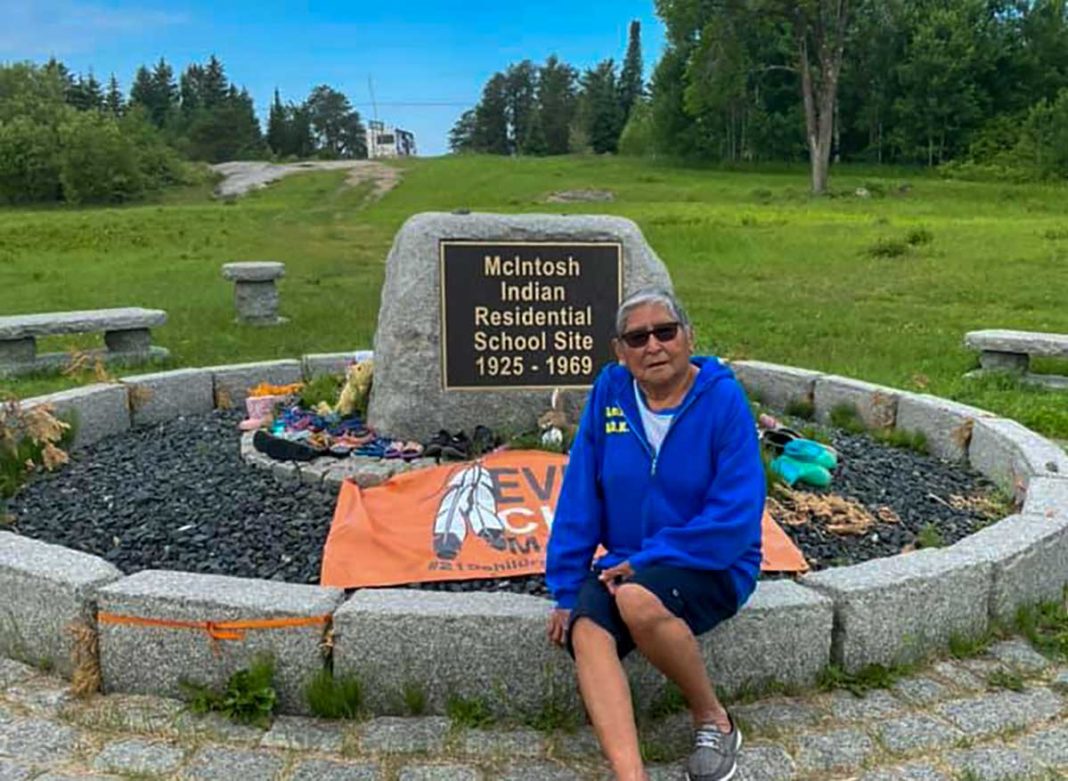Elaine Nawegahbow defied residential school stereotypes to thrive
AUNDECK OMNI KANING – Ripped from the bosum of her Oji-Cree family at the tender age of six, Moonias (Elaine Nahwegahbow) would endure eight years in the MacIntosh Residential School in Northwestern Ontario. It was an experience that would alienate Ms. Nahwegahbow from her family and place its indelible mark on her and her family. Ms. Nahwegahbow delivered a prayer at the recent Every Child Matters event on July 1 held in Aundeck Omni Kaning. Her story was inadvertently left out of the report on that event, adding an extra pain to her family’s experience, an omission The Expositor regrets. What follows is her story as related to this newspaper in a follow-up interview.
“Before I went to residential school, we lived a good life,” recalled Ms. Nahwegahbow. “My dad was a trapper and we lived off the land. We were always together.” Like many Indigenous trappers down through the centuries her father made a good living selling his furs to the Hudson’s Bay Company. In the summer he would create snowshoes, the excess production of the famed winter footwear could be sold to the company.
“My mother said I was a chubby child in those days,” she said. “I was always dancing when they played music.” She was, by all accounts, a very happy child.
Ms. Nahwegahbow’s family was from Marten Falls, an hour-long floatplane ride to the railhead where the young six-year-old was placed aboard a train bound for the residential school in MacIntosh. She suddenly entered an alien world for which her earlier life had left her ill-equipped.
“I didn’t speak any English,” she recalled. The train ride was a very frightening experience for the young child, but she was not alone, as several other small frightened children were on the train. The one bright spot was a Black conductor who gave them candy to try and calm them down. “He was very nice,” she said. “Some of us were crying, he made us laugh and forget for a little while.”
Ms. Nahwegahbow had seen a train before, as her father sometimes worked on the railroad. “So I knew about white people, people different than us,” she said.
McIntosh Indian Residential School was a residential school opened by the Catholic Church in 1924. The school was located between Forest Lake and Canyon Lake. The main school building was burned down by a fire in 1969 and only the chapel remains standing today. A memorial sits near the site of the former school as a reminder of the forced assimilation and abuse to generations of Indigenous children.
Arriving at the residential school, Ms. Nahwegahbow had her hair cut and was dusted with white powder to kill any potential body lice she might be carrying—a standard practice that greeted young Indigenous children when first arriving at the schools and which set the theme of “dirty Indian” that would reoccur throughout her schooldays. She was also given a number, and it was this number that would be her name while attending the school.
“I took my mom there,” said Ms. Nahwegahbow’s daughter Irene Altiman. Ms. Altiman described the journey down a lonely dirt road to the site which lies on the rail line, but is no longer served by rail.
Ms. Nahwegahbow recalled the diet at the school, in which liver featured regularly as an evening meal. Snacks included raw turnip and, a favourite of hers to this day, peanut butter and brown sugar sandwiches for a treat. There were some bright spots, including trips to the sugar bush in the spring and the occasional barge ride.
But for many of the children, including Ms. Nahwegahbow, the food was very different from what they were accustomed to. The first time she returned to her family, Ms. Nahwegahbow had been transformed into a skinny child.
Trips home were very rare, given the distances involved, and most Christmas holidays were spent at the school. “Christmas was the big feast,” she recalled.
After a while, Ms. Nahwegahbow said that she became estranged from her family. “I was losing my family, I didn’t want to go home,” she said. Many of the people from her earlier life had become strangers to her in the intervening years. “I didn’t know them when I came home,” she said.
In her last year of residential school at MacIntosh, Grade 8, one of the sisters who had taken a liking to the young girl gave her a suitcase and clothes for her birthday. “Her name was Sister Albert, I think,” said Ms. Nahwegahbow.
Ms. Nahwegahbow’s cousin Chanie (Charlie) Wenjack was attending nearby Cecilia Jeffrey Indian Residential School in Kenora when he became lonely and ran away, following the railroad tracks. The 12-year-old Ojibwe boy was found frozen and starved, dead along the tracks trying to make it home the 800 kilometres. His fate was immortalized in a song by Gord Downey and the Tragically Hip and documented in the book ‘Wenjack’ by Joseph Boyden. Ms. Nahwegahbow remembers Chanie as a young boy.
Chanie Wenjack was born on the Ogoki Post on the Marten Falls Reserve. At the age of nine he was forced, along with his two sisters, to attend the Cecilia Jeffrey Indian Residential School in Kenora. Once there he was given the name Charlie. The school was funded by the Canadian government and overseen by the Women’s Missionary Society of the Presbyterian Church. At the time, 150 students attended the school. He was known to have a good sense of humour, according to the principal at the time, and was always the first to recognize a pun or riddle.
Ms. Nahwegahbow’s memories of residential school are rife with examples of how the children were demeaned and made to feel less than worthy as human beings. She recalled one incident when the children were engaged in the time-honoured game of shooting spitballs at the ceiling. The nuns forced the children to pick up the pieces of saliva-wet paper from the floor with their mouths.
Ms. Nahwegahbow went on to attend St. Mary’s High School before spending a year at Winnipeg’s Assiniboia High School. She went on to work in a tourist camp with two of her friends from school.
“One of the big downfalls for us as a family was the loss of language,” said daughter Bev Abotossaway. Because of that loss, the grandchildren could not speak to their grandparents, who never learned English. “We knew they cared for us, but we could not talk to each other.”
Ms. Nahwegahbow moved to Sudbury, where she took upgrading at a vocational school at night and met her husband Henry. “He was in college,” she said. Her husband went on to enjoy a career at INCO until the six-month strike of 1967. “We couldn’t afford to be on strike,” she recalled. The couple eventually moved back to Mr. Nahwegahbow’s home community of Aundeck Omni Kaning.
Ms. Nahwegahbow worked at the hospital in Little Current until a car accident one evening made her and a colleague late for work. They were summarily fired. Undaunted, Ms. Nahwegahbow went on to several careers, including as a social worker and administrator—she even tried her hand at becoming a language teacher, but decided that was not for her.
Her family did not know their mother went to residential school, noted Ms. Altiman.
“She never talked about it,” said Ms. Abotossaway.
The first time Ms. Nahwegahbow opened up about her experiences was during a workshop hosted by Shirley Cheechoo of M’Chigeeng. That experience helped open the floodgates for her children and eventually led to a pilgrimage with her daughters to the site of residential schools, including many of the places around the school where she spent so much of her childhood.
Ms. Nahwegahbow’s own children grew up in a Christian household (not Catholic, her experiences at a Catholic-run residential school put paid to that possibility) that eschewed the traps of alcohol and substance abuse. But the impact of the residential school system remained.
“We always knew our mother loved us,” said Yvonne Nahwegahbow. “But there was no hugging or other physical contact.”
The children had rules to follow, certain clothes were worn to go to school, but removed as soon as they got home. The house was always immaculate and home life tended to be quite regimented. “At the school there was a bell to get up in the morning and another for meals and another to go to bed,” recalled Ms. Nahwegahbow. It was an institutional environment to grow up in and was translated into her own family’s life as they grew up.
Ms. Nahwegahbow managed to bridge the divide that residential school attempted to instill. Although she did not teach her children Anishinaabemowin and her children did not even know what a powwow was until much later in life, she still managed to overcome the challenges of an institutional upbringing and set in place the core values that allowed them to lead productive and community and family centred lives.
Hers is a story of resilience and determination that lies at the foundation of a resurgent Indigenous story, bent but unbowed before the winds of colonialism, and stands as a testament to the resilience of the Indigenous communities and individuals who make up Canada’s First Nations.





